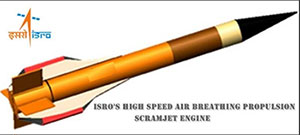(HOT) UPSC Current Affairs 2025 PDF
NEW! The Gist (NOV-2025) | E-BOOKS
SCRAMJET: Important Topics for UPSC Exams
SCRAMJET: Important Topics for UPSC Exams
 What
is it?
What
is it?
- India successfully tests its own scramjet engine in flight on board an Advanced Technology Vehicle rocket.
- Two scramjet engines were tested during the flight from Sriharikota.
- It uses oxygen from the atmosphere as fuel therefore weight of the system is less and their efficiency is more.
- Scramjet engines designed by ISRO uses hydrogen as fuel and the oxygen from the atmospheric air as the oxidiser.
- Similar systems are: Ramjet, Dual Mode Ramjet (DMRJ).
- It is also called Supersonic Combustion Ramjet.
- USA is the 1st country to test Scramjets in 2002. Thereafter Russia, European Agency, Japan and China have also tested this technology. India is the fourth country to demonstrate the flight testing of scramjet engine.
Ramjet vs. Scramjet
- Both scramjet and ramjet engines use the space craft’s forward motion to compress incoming air without an axial compressor.
- Since scramjets cannot produce thrust at zero airspeed, they cannot move a space craft from a standstill. A scramjet-powered vehicle, therefore, requires an assisted take off by a rocket to accelerate it to a speed where it begins to produce thrust.
- It has been found that scramjet engines work most efficiently at supersonic speeds between Mach 3 and Mach 6. A ramjet engine on the other hand can work at subsonic speed.
- Both ramjet and scramjet engines use atmospheric oxygen as oxidizer.
- While exit flow from the inlet of a ramjet engine is subsonic that from a scramjet engine is supersonic.
What is Mach
- The word Mach comes from Ernst Mach, a brilliant 19th century scientist whose most famous contribution was in the area of the speed of sound.
- Mach 1 means the speed of sound that is 1195 km/hr in air.
- A rocket flying at Mach 1 speed means it is going at the speed of sound in a particular medium say air. Mach 2 means twice the speed of sound.
What is its significance?
- Scramjets are very important for ISRO’s future plans.
- Currently used PSLVs are expendable meaning that they could be used only once. In future, ISRO wants to use rockets FITTED with scramjets because their launching cost will be much less than that of the conventional rockets.
- ISRO will become cost effective destination for space industry and may grab a big bite in the multi-billion dollar ( $100 bn and is expected to climb $330 bn in coming years) space market.

